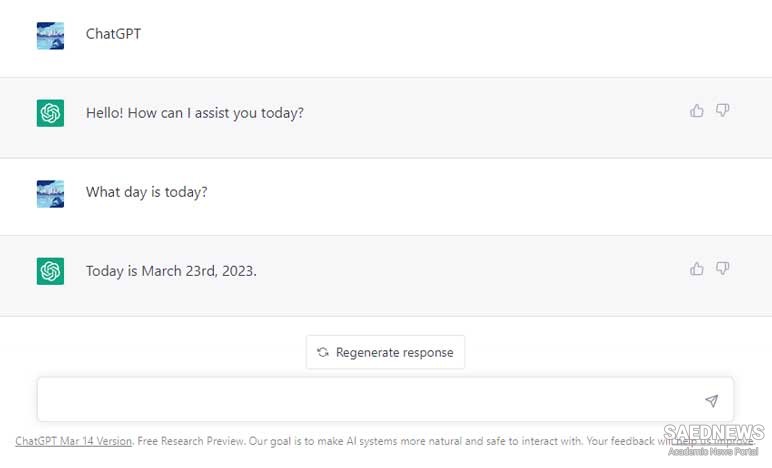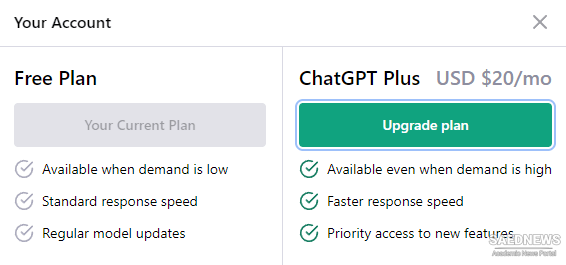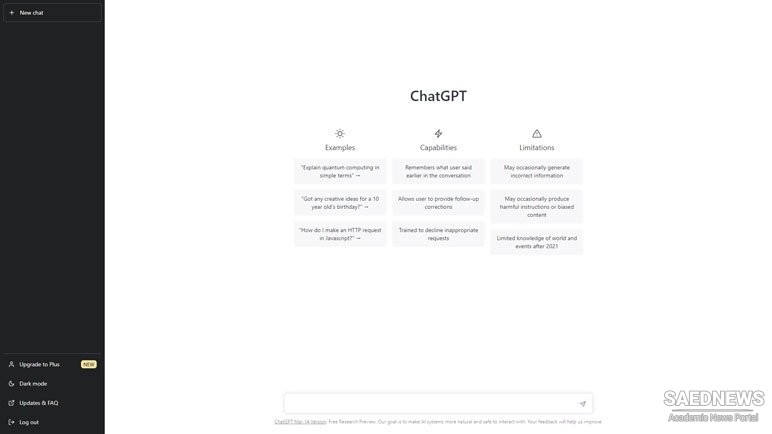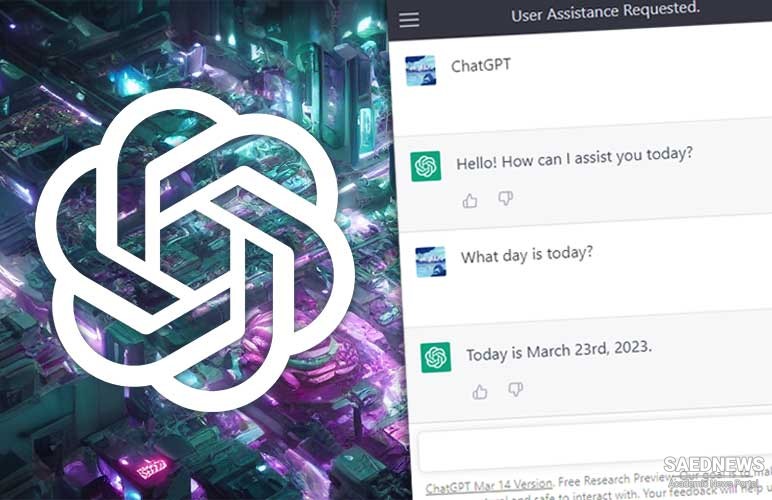ChatGPT is an AI chatbot developed by OpenAI and launched in November 2022. It has the power to revolutionize everything from customer service to how we conduct online searches.
What Is ChatGPT ?
The first question is, what is ChatGPT? ChatGPT is a sophisticated artificial intelligence language model that uses the GPT (Generative Pre-trained Transformer) architecture to analyze and respond to natural language inputs. It was created by OpenAI, a leading research organization focused on developing advanced AI technologies.
The GPT-3.5 and GPT-4 architecture used in ChatGPT was trained on a massive dataset of text from various sources, including books, articles, and websites. Through this training, the model has learned to understand the structure and patterns of human language and can generate responses that are contextually relevant and grammatically correct.
As a language model, ChatGPT is capable of engaging in conversational interactions with users, answering questions, providing information, and generating text that mimics human language. It has many practical applications, including chatbots, virtual assistants, and content creation tools.
ChatGPT is considered a state-of-the-art language model and has generated significant interest in the AI research community. Its development has opened up new possibilities for natural language processing and has the potential to revolutionize the way we interact with technology.
What Can ChatGPT Do?
As an AI language model, ChatGPT is capable of understanding and generating human-like language. This means that it can take in text input and generate output that is grammatically correct, coherent, and contextually appropriate. Some of the tasks that ChatGPT can perform include:
- Language Modeling: ChatGPT can generate text that follows the patterns and rules of a particular language.
- Sentiment Analysis: ChatGPT can analyze the sentiment of a piece of text, whether it is positive, negative, or neutral.
- Text Classification: ChatGPT can classify text into different categories based on its content, such as news articles, social media posts, or customer reviews.
- Language Translation: ChatGPT can translate text from one language to another, taking into account grammar, vocabulary, and context.
- Text Summarization: ChatGPT can summarize long pieces of text into shorter versions while retaining the most important information.
- Question-Answering: ChatGPT can answer questions based on the information provided, using its knowledge of language and context to provide accurate responses.
Overall, ChatGPT is a powerful tool for language-related tasks that can improve efficiency and accuracy in a variety of applications, from chatbots and customer service to content creation and language learning.

How To Use ChatGPT?
ChatGPT is an AI-based chatbot that has been trained using large amounts of data and advanced machine learning algorithms to respond to user inputs in natural language. Here is how to use ChatGPT:
As a user, you can simply ask a question or start a conversation in the chat window. ChatGPT will then use its natural language processing algorithms to generate a response based on its training data and its understanding of your input.
To get the best results, it's important to ask clear and specific questions or provide as much context as possible for the conversation. You can also try to use natural language and speak in complete sentences, just as you would in a conversation with another person.
It's worth noting that ChatGPT is a language model designed to simulate human-like conversation, but it may not always provide accurate or reliable information. It's always a good idea to verify any information you receive from ChatGPT with additional sources.

ChatGPT Plus Price
How much is a ChatGPT Plus subscription? ChatGPT, being an immensely popular language model, has prompted its creator to release a paid version called ChatGPT Plus, which is available at a monthly subscription of $20. The main advantage of ChatGPT Plus is the priority access it offers to the platform, ensuring that users receive quicker responses to their queries. Moreover, this version has overcome certain limitations of the free version, enhancing the overall user experience.
The ChatGPT Plus subscription also offers access to GPT-4, the latest language model from OpenAI. It is currently available only to ChatGPT Plus subscribers.
Customers worldwide can subscribe to ChatGPT Plus and leverage its exclusive features.
What is the Difference Between ChatGPT Free and ChatGPT Plus?
There are two plans available for ChatGPT, a free plan and a paid plan called ChatGPT Plus. The key differences between the two plans are:
- Increased Response Accuracy: With ChatGPT Plus, you will receive more accurate responses as it utilizes a more advanced language model with a larger training dataset. This means you can expect a more detailed and nuanced response to your questions compared to your free plan.
- Customization: ChatGPT Plus offers more customization options, such as the ability to personalize responses, use custom response templates, and create custom models tailored to specific use cases. This makes it a better choice for businesses and individuals who want more control over the responses generated by the AI model.
- Usage Limits: The free plan has certain usage limits, such as the number of API requests per month, while ChatGPT Plus offers higher usage limits or unlimited usage, depending on the specific plan you choose.
- Priority Support: ChatGPT Plus offers priority support to its users, which means that they receive faster and more dedicated assistance from the support team in case of any issues or concerns.
- Pricing: ChatGPT Plus is a paid service, whereas the free plan is, well, free. However, the cost of ChatGPT Plus varies based on the plan you choose and the usage limits required, so it's important to evaluate your needs and budget before deciding on a plan.
Overall, ChatGPT Plus offers a more advanced and feature-rich AI language model compared to the free plan, making it a better choice for businesses or individuals with higher usage needs or those who require more advanced customization options.
Where Does ChatGPT Get its Data?
As an AI language model, ChatGPT has been trained on a large dataset of text data, which was compiled from various sources on the internet. The dataset used to train ChatGPT includes a wide range of text sources, such as books, articles, websites, social media posts, and more.
The data used to train ChatGPT was sourced from various publicly available sources, such as online libraries, news websites, academic papers, and other online repositories. The data was carefully curated and preprocessed to remove any noise or biases that may affect the model's performance.
It's worth noting that ChatGPT was trained on a massive amount of data, consisting of millions of text examples, which helps it to generate human-like responses and understand various language nuances.
Is ChatGPT Replacing Google?
No, ChatGPT is not designed to replace Google. ChatGPT is an AI language model that can generate human-like responses to text-based queries, while Google is a search engine that allows users to search the internet for information, images, videos, and other types of content.
Both ChatGPT and Google serve different purposes and have their own strengths and limitations. While ChatGPT can be used for a wide range of applications, such as chatbots, language translation, content creation, and more, it cannot search the internet like Google.
Google, on the other hand, excels at finding information on the internet quickly and efficiently, and it offers a range of other services such as email, cloud storage, and productivity tools that are not available in ChatGPT.
Therefore, ChatGPT and Google are complementary tools that can be used in different ways to enhance productivity and efficiency.
Who Owns ChatGPT?
ChatGPT is a product of OpenAI, a nonprofit research company that focuses on developing advanced artificial intelligence technologies in a safe and responsible manner. Founded in 2015 by a group of renowned tech entrepreneurs and researchers, OpenAI has received significant funding from private investors and philanthropic organizations to support its mission. While OpenAI is governed by a board of directors and managed by a team of executives and researchers, ChatGPT is an autonomous language model that is constantly learning and improving based on the data it processes. As an AI-based platform, ChatGPT does not have an individual owner or controller, but rather exists as a tool for users to interact with and gain knowledge from.

What are the Limitations of ChatGPT?
Here are 10 limitations of ChatGPT, along with examples to illustrate each one:
- Lack of knowledge on current events: Since ChatGPT's knowledge cutoff is 2021, it may not be aware of current events or news that have happened since then. For example, if someone asks ChatGPT about the winner of the 2022 World Cup, it may not be able to provide an accurate response.
- Difficulty understanding sarcasm or humor: ChatGPT may have difficulty understanding sarcasm or humor in a conversation, which could lead to inappropriate or nonsensical responses. For example, if someone says "Great, now I'm stuck in traffic for hours" in a sarcastic tone, ChatGPT may not pick up on the sarcasm and respond with something like "I'm sorry to hear that, is there anything I can do to help?"
- Inability to provide personalized advice: ChatGPT is not able to provide personalized advice that takes into account an individual's unique circumstances. For example, if someone asks ChatGPT for financial advice, it may not be able to provide personalized advice based on the person's income, debts, and other financial factors.
- Lack of understanding of cultural or regional differences: ChatGPT may not be familiar with cultural or regional differences in language or customs, which could lead to misunderstandings or inappropriate responses. For example, if someone asks ChatGPT for advice on dating in a specific culture, it may not be able to provide accurate advice if it is not familiar with the culture.
- Tendency to generate generic or repetitive responses: ChatGPT may generate generic or repetitive responses to certain types of questions or topics, which could be frustrating for the person asking the questions. For example, if someone asks ChatGPT for advice on dealing with stress, it may generate a generic response like "Try to relax and take deep breaths" without providing any additional context or personalized advice.
- Difficulty understanding complex or technical language: ChatGPT may have difficulty understanding complex or technical language in a conversation, which could lead to inaccurate or nonsensical responses. For example, if someone asks ChatGPT to explain the nuances of quantum mechanics, it may not be able to provide an accurate or detailed response.
- Inability to understand non-verbal cues: ChatGPT is not able to understand non-verbal cues like tone of voice, facial expressions, or body language, which could lead to misunderstandings or inappropriate responses. For example, if someone asks ChatGPT if they are angry, it may not be able to detect the person's tone of voice or facial expression and could respond with something like "No, I'm not angry".
- Tendency to generate irrelevant or off-topic responses: ChatGPT may generate irrelevant or off-topic responses to certain questions or topics, which could be frustrating or confusing for the person asking the questions. For example, if someone asks ChatGPT for advice on how to fix a leaky faucet, it may generate a response about how to install a new sink instead.
- Difficulty with spelling and grammar: ChatGPT may generate responses that contain spelling or grammar errors, especially when it comes to complex or technical language. For example, if you ask ChatGPT to proofread a document, it may miss certain errors or generate its own errors in the process.
- Limited memory capacity: ChatGPT has a limited memory capacity, which means it may not be able to remember information from previous interactions. For example, if you ask ChatGPT to remind you of something you mentioned earlier in the conversation, it may not be able to recall that information.

















































